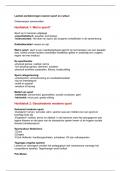Summary
Summary articles + book Talent Development & Creativity
- Module
- Institution
- Book
This summary consists of all the articles (except 2) for the course Talent Development & Creativity and chapters 2, 8, 9 and 18 of the book 'The Complexity of Greatness: Beyond Talent or Practice' from Kaufman.
[Show more]












